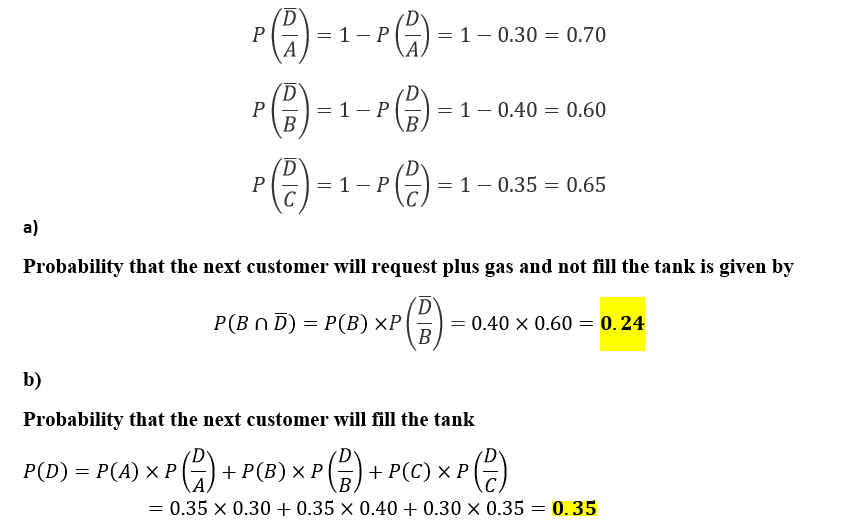At a certain gas station, 35% of the customers use regular gas, 35% use plus gas, and 30% use premium. Of those customers using regular gas, only 30% fill their tanks. Of those customers using plus, 40% fill their tanks, whereas of those using premium, 35% fill their tanks. a. What is the probability that the next customer will request plus gas and not fill the tank? b. What is the probability that the next customer fills the tank? c. If the next customer does not fill the tank, what is the probability that regular gas is requested? Plus? Premium?
Compound Probability
Compound probability can be defined as the probability of the two events which are independent. It can be defined as the multiplication of the probability of two events that are not dependent.
Tree diagram
Probability theory is a branch of mathematics that deals with the subject of probability. Although there are many different concepts of probability, probability theory expresses the definition mathematically through a series of axioms. Usually, these axioms express probability in terms of a probability space, which assigns a measure with values ranging from 0 to 1 to a set of outcomes known as the sample space. An event is a subset of these outcomes that is described.
Conditional Probability
By definition, the term probability is expressed as a part of mathematics where the chance of an event that may either occur or not is evaluated and expressed in numerical terms. The range of the value within which probability can be expressed is between 0 and 1. The higher the chance of an event occurring, the closer is its value to be 1. If the probability of an event is 1, it means that the event will happen under all considered circumstances. Similarly, if the probability is exactly 0, then no matter the situation, the event will never occur.
At a certain gas station, 35% of the customers use regular gas, 35% use plus
gas, and 30% use premium. Of those customers using regular gas, only 30%
fill their tanks. Of those customers using plus, 40% fill their tanks, whereas of
those using premium, 35% fill their tanks.
a. What is the
fill the tank?
b. What is the probability that the next customer fills the tank?
c. If the next customer does not fill the tank, what is the probability that regular
gas is requested? Plus? Premium?
Let A be the customers that uses regular gas
P(A) = 0.35
Let B be the customers that uses plus gas
P(B) = 0.35
Let C be the customers that uses the premium
P(C) = 0.30
Let D represents the customer will fill the tank
P(D/A) = 0.30
P(D/B) = 0.40
P(D/C) = 0.35
The Customers who will not fill their tank

Step by step
Solved in 3 steps with 2 images




